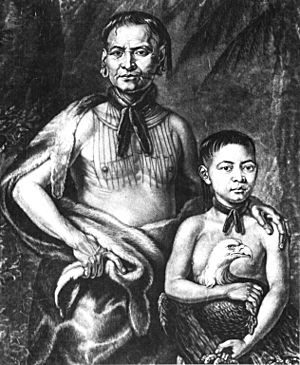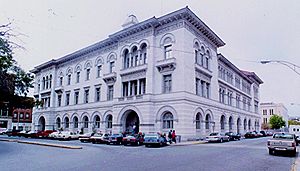Tomochichi facts for kids
Tomochichi (pronounced to-mo-chi-chi') was an important Native American chief who lived in the 1700s. He was the leader of the Yamacraw people, whose village was located where the city of Savannah, Georgia is today. Tomochichi played a big part in the early history of Georgia. He worked closely with James Oglethorpe, who was the leader of the first British settlers. Tomochichi helped create peace between his people and the new settlers, which was very important for the success of the Georgia colony.
Early Life and Leadership
We don't know much about Tomochichi's early life. He was originally from the Creek nation but left for reasons that are not fully clear. He and his followers then settled in the area that is now Savannah, Georgia.
Around 1730, Tomochichi formed his own group called the Yamacraw. This group was made up of people from both the Creek and Yamasee tribes. These two tribes had different ideas about how to deal with the British and Spanish. Tomochichi's group, about 200 people, settled on the bluffs of the Savannah River. This spot was special because his ancestors were buried there, and it was close to British traders.
When James Oglethorpe and the first British settlers arrived in February 1733, they knew they needed to make friends with the Native American tribes. If they didn't, their new colony might not succeed. Mary Musgrove, whose mother was Creek and father was English, helped as an interpreter. She and her husband, John, helped Oglethorpe and Tomochichi talk to each other.
Tomochichi had met British colonists before, so he wasn't scared, but he was careful. He decided to welcome the new settlers and let them build Savannah. He saw this as a chance for his people to trade and build good relationships with the British.
Tomochichi became a lifelong friend to the early British colonists. He helped them make a treaty with the Lower Creeks, which also helped solve old disagreements within the Creek nation.

Working with the British
Tomochichi believed that his people should be educated. He worked with Benjamin Ingham, a friend of John Wesley and Charles Wesley, to open a school for Native American children at a place called Irene in September 1736.
Tomochichi gave a lot of help to the new Georgia colony during its first five years. One year after Oglethorpe arrived, Tomochichi traveled with him to England. A small group of his family and other Lower Creek tribesmen went too. In England, Tomochichi was an excellent representative for his people. He met many important British leaders.
On August 1, 1734, he met King George II at Kensington Palace. As a sign of peace, he gave the King eagle feathers. Tomochichi's trip allowed him to be there when the "Articles of Friendship and Commerce" were officially approved. This was the treaty that he and Oglethorpe had agreed upon, allowing British settlers to live at Yamacraw Bluff, which became Savannah.
Tomochichi was polite and followed English customs during his public appearances. At the same time, he strongly pushed for his people's needs, like education and fair trade. When he returned to Georgia, Tomochichi met with other Lower Creek chiefs. He told them that the new British settlers had good intentions. He convinced them to form an alliance with the British leaders in Georgia.
After Oglethorpe came back to Georgia in February 1736, Tomochichi met with John Wesley, Charles Wesley, and Benjamin Ingham. Tomochichi again asked for Christian education for his tribe. John Wesley's answers were complicated, but Benjamin Ingham helped create the school at Irene, which made the elderly chief very happy.
In the same year, Tomochichi and Oglethorpe went on a trip to figure out Georgia's southern borders. Tomochichi also helped calm tensions with the Spanish. He worked hard to keep the peace, and Oglethorpe often asked him for advice. In 1739, Tomochichi met with a group of Choctaw leaders who were meeting with the British in Savannah.
Death and Legacy
Tomochichi died on October 5, 1739. Most historians believe he was 95 years old. Before he died, he told the Creek Indians to remember how well the King had treated them and to remain friends forever. The colony gave him a public funeral, which was a British military funeral. His grave was marked with a "Pyramid of Stone."
His wife, Senauki, and his nephew, Toonahowi, took over leadership of the tribe. However, Tomochichi did not name anyone to take his place as the main go-between for the Native Americans and the settlers.
The original monument marking his grave was later destroyed. In the late 1800s, a new monument was placed in his memory. It was a large granite boulder with a copper plate, put there by the Georgia Society of The National Society of The Colonial Dames of America. Later, the Georgia Historical Commission placed a large marker in Savannah's Wright Square, which tells about Tomochichi's important achievements.
The Tomochichi Federal Building and U.S. Courthouse in Savannah is named in his honor.
See also
- Statue of Tomochichi
 In Spanish: Tomochichi para niños
In Spanish: Tomochichi para niños



